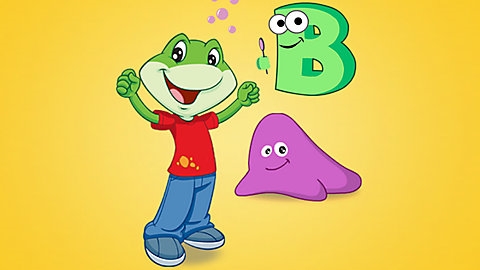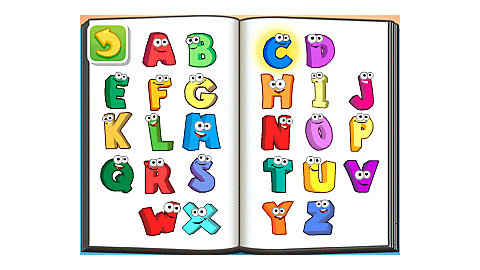Letter Factory
Why you should use characters when designing a 3-5 year old title for a good user experience.
LeapFrog has been making digital learning games for many years for 4-9 year olds, but in 2011 the company decided it needed to expand its portfolio into the 3 year old demographic market. The company decided on three titles to launch their 3-5 year old line up and The Letter Factory was one of them. The Letter Factory franchise is one of the LeapFrog's most successful IPs. It stars LeapFrog's iconic characters: the Frogs and the Talking Letters. (A quick background on the franchise: The Letter Factory is a place that produces talking letter that can say their names and their letter sound i.e. Letter A can say A and Ahh).
The Problem:
I was put in charge of the design for this title so I was sailing uncharted waters in terms of how to create interactions and incentives for 3-5 year olds. There were so many unknown variables from game design to usability experience for this new age span and especially the 3 year olds. Developmentally a 5 year old is leap and bounds way more developed than a 3 year old so creating a game that can work across 3, 4 and 5 years olds at the same time was and still is a challenge.
The biggest unknown is the age 3 group and how to design for them. First up discovery and empathizing with the main demographic. I started by asking lots of questions like how do they play with digital and non-digital toys, what motivates them, how long are play times etc...then committed to doing lots of research by performing qualitative kid play testing, controlled observation (quantitative/qualitative data) and interviews using LeapFrog's Kid Lab on existing LF games, competitive games & products on the market, and then defining and summarizing the findings to communicate to the team and stakeholders what worked. I learned a lot more than I was expecting and too much to write about In this study but below are 3 major checklist items to consider when making a title for 3-5 years olds in term of content presentation and UX design. I'll walk you through the reason behind each item.
Where to Start?
Here's the main question I asked myself when developing this title: How do you get a kid to care about the game or the activity they are doing? It came down to how do I create a relationship with them and give them a clear and simple goal that means something to them. Kids in this age range don't care so much about meta-game and complex long and short term goals for extrinsic rewards like leaderboards etc...but if you build a connection with them and give simple scaffolding and clear goals then you're more than likely to get a good result. So how do you create this scenario?
Characters:
In-game Characters are a very powerful tool. Remember this! Characters create a powerful link between the game and the player. They are the bridge between the screen and the real world. Many games that were tested in the discovery phase had a big character appeal. As noted above the Letter Factor IP is one of LeapFrog's most popular IP. The characters are known and trusted. We took advantage of characters on this title in many different ways. We'll go over how I used characters to:
Create a relationship with the player
Communicate important points
Provide meaningful feedback
1) Establishing a Relationship:
In The Letter Factory we established a relationship with player immediately. At the launch of the game we introduce the kids to the game's characters with a simple and cute non-interactive screens (NIS), where the characters introduced and talked about each other briefly (see screen cap above). By doing this it created a safe environment where there is dialog between the host characters onscreen and the player. The in-game characters and the player are now "friends" and familiar. It's important to have this setup and continue to reinforce it throughout the game. With the NIS we kept everything simple and as short as possible. In the NIS we introduced the characters, the problem, and the goal calling for help.
2) Communicating Important Information:
In the game we introduced the player right away to a new character named Burfder. Burfder is young cute talking letter resin who can transform into many things; however, he doesn't know which letter he wants to be. He asks his new friend the player to help him on his journey to learn more about the letters. Right there we communicated the goal of the game, help Burfder learn and decide what letter to be. To hook the player's attention during the NIS we gave Burfder cute and fun transformation animations that was exposed immediately in the intro NIS. Burfder's situation is relatable. He's a young kid, he needs help and is cute and nonthreatening. He's a friend that needs help.
We continued to use Burfder and the Frogs throughout the game to communicate important milestones reached by the players. Kids want to be helpful and want to contribute. Having a friend in need of help is a clear goal to understand and relate to. However only having this goal for the youngest player is not enough, we needed to make sure to have scaffolding that constantly shows the player's progression towards helping Burfder. Again you'll get the best result if you use a character to communicate this. Whenever we hit a game milestone achievement we would transition to a screen that had big character presence.
Ask kids to help in a nice way. You put them in a situation where they will care about. In the case of the Letter Factory we introduced a new character named Burfder. Burfder is a talking letter resin, who can't decide which letter to be.
3) Provide Meaningful Feedback:
Because of the curriculum and assessment one of the most important points with LeapFrog's content is communicating feedback for correct or wrong answers and how to guide the player to the correct answer when needed. Again to address this need on how to communicate clearly and meaningfully to the player we use the character relationship we have established with the player in the NIS.
In each of the section in the world and in the minigames screen area there are characters there to greet and host each activity. With how important it is to have that character presence, we had to solve the issue of how much how much space to give the characters on the screen. The goal was to get as much visual presence as possible without compromising too much of the play space and the HUD needed for curricular questions.
Now how much room do the characters need to be effective in communicating feedback? With many rough sketches and wireframes and kid testing, we decided that 1/8 of the screen is the best size for the characters. In the images above you can see one of the many rough sketches and the final result from the screen real estate breakdown study. With all the comps we made we did a few qualitative A/B testing with kids to get the best results for composition readability and overall appeal. At the end the character were the perfect size for giving meaningful feedback during curriculum and game sessions. Kids responded very well to character prompts and corrections.
4: Bonus: Toy Like Experience:
This is a topic on its on and perhaps I'll make another post on it but I wanted to mention that even though this is a learning game it's important to try to create a toy like experience for this demographic. What I mean by this is that yes this is a game with rules, choices, and decision junctions but ignore all that and insert little things that make it joyful and replayable like a toy. In the images above you'll see a few examples. We created a small replayable hide and seek game with the letters called Where's Letter. Kids would walk around the factory floor searching for all the letters. In the other example we have an element called "Clickables." The Clickables were scattered all over the environment so kids would again go around looking for them. Each Clickables produced 3 small fun animations and sound effects. And lastly going back to characters, Burfder was cute and fun because he was able to morph and transform to fun things that kids can relate too: tube, helicopter, a car etc.... Creating little things like this made the game into a toylike experience that gave it more life, joy and replayability.
Summary
Characters are important! You can do a lot with characters so take advantage of them if you can. Use them to: Create a meaningful relationship to get the kids to care, give important information about the game, and give feedback in a meaningful way where kids will care. They are the bridge between the screen and the real world!
Letter Factory Game
Curriculum: Phonics / Early Reading Title
Demographic: Age 3-5
Platform: All LeapFrog Devices






















